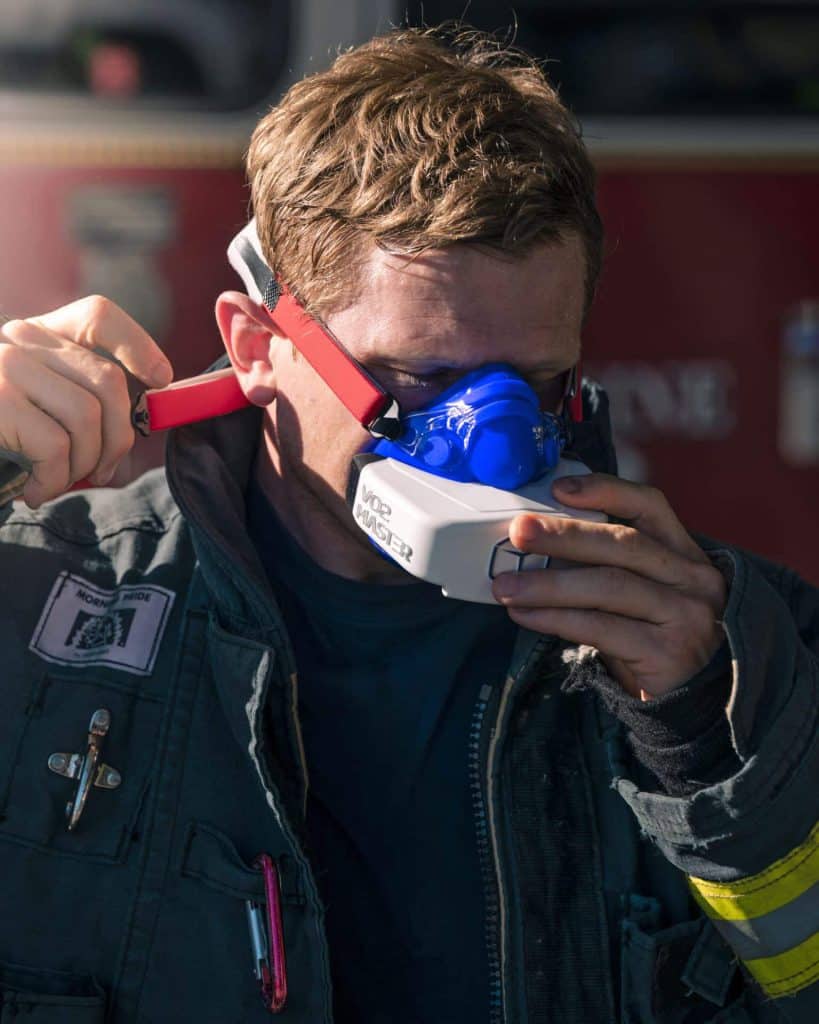Normal (and Abnormal) Breathing Patterns at Rest
In this edition of the VO2 Master Education Series, performance coach Sean Seale chats with Dr. Andrew Sellars, Co-Founder of VO2 Master, about breathing patterns at rest, respiratory frequency, and volume. Read through the full details of their conversation below. Sean Seale: What should we see at rest in terms of respiratory frequency? Dr. Sellars:Continue reading "Normal (and Abnormal) Breathing Patterns at Rest"

In this edition of the VO2 Master Education Series, performance coach Sean Seale chats with Dr. Andrew Sellars, Co-Founder of VO2 Master, about breathing patterns at rest, respiratory frequency, and volume.
Read through the full details of their conversation below.
Sean Seale: What should we see at rest in terms of respiratory frequency?
Dr. Sellars: There’s a good range and it does depend a little bit on age factors and lung volume factors. But typically we see respiration rates, or respiratory frequencies, in the range of 6-12 at rest.
If we see something that’s either much lower or much higher than that range, what can it indicate to us?
High respiratory frequencies do sort of push towards some sort of stress response. There’s usually an indication or reason, that a patient or an athlete is breathing fast. It either has to do with challenges in the lungs or the lungs aren’t exchanging air the way they should.
We see that in people with COPD or asthma; medical conditions that cause poor airflow or poor exchange across the lung surfaces. We also see it in medical conditions like anxiety and hyper-alert responses to things.
A fear response is typically something we see quite often in a medical setting because patients are anxious about being where they are; either in a hospital or a doctor’s office.
If we notice it in a rested person, then it does raise the concerns that there should probably be further investigations, or at least a discussion, about why the person has defaulted to a faster breathing pattern. They may or may not be aware of it and they may not be in tune with the anxiety, the feeling inside, or other concerns that they might have if they were aware of their breathing patterns.
The slow breathing pattern is probably less of an issue, especially if you’ve read recent literature or the book The Oxygen Advantage by Patrick McKeown. It talks about the benefits of slow breathing.
In most circumstances, slow breathing is beneficial. It has some physiologic benefits; the primary one is not an oxygen shift, but it’s actually a carbon dioxide (CO2) shift. Slower breathing raises carbon dioxide levels in the blood, which helps vasodilate peripheral systems that increase blood flow and increase oxygenation to the tissues.
Physiologically, there are benefits to the heart and to the brain with elevated CO2 levels within a set range. Slower breathing, by control, is not a bad thing.
There are some medical conditions that have reduced breathing volumes. There are some neurologic conditions and some central apnea issues where people have an underlying condition that does not trigger a normal breath response.
Fairly rare, but worth looking into if the person is not consciously controlling their breathing down to a slow level. It potentially could lead to lower oxygen levels, because they’re not breathing enough.
But in most circumstances, slow breathers are actually quite fit individuals who’ve done some respiratory training and have better control of their respiratory status.
What tidal volumes can we expect to see in someone at rest?
The tidal volumes and respiratory frequency together combine to form the physiologic parameter of ventilation.
Similar to heart rate and stroke volume. Respiratory frequency and tidal volumes, multiplied together equal the ventilation, which we typically report in litres/minute.
A sinusoid, a wave, is a typical breathing pattern in a relaxed person. 0-6000mL or 0-6L is a typical volume for an average size male.
We talked previously about spirometry and the fact that lung volumes and sizes are quite closely related to the height of an athlete. So, the taller you are, the larger the lung volumes we expect to see.
There are normative values and data available to compare your lung volumes to the average people the same height as you. When people are resting, they use about 500mL/breath. The middle range of their lung volumes, 2400-2900mL or the part that’s around 3-6L, is not typically used at rest.
They could blow out more air and they could inhale more air if they needed to. But they typically use a middle range of about 500mL/breath on average, depending on their size, how rested they are and how stimulated they are to actually take those breaths.
Why do we see that in the middle range and not the lower range?
It has to do with a couple of different factors.
It has to do with pressure; there’s a static pressure within the lungs. The lungs are very similar to a soft sponge that you can squeeze water out of and release it.
To to blow all the air out means you actually have to squeeze the lungs and you have to squeeze it using intercostal muscles. The diaphragm when it’s fully exhaled is actually in a relaxed position.
So, you have to fully relax the diaphragm and you have to squeeze the ribcage down smaller. There’s an elastic recoil of the ribcage up to a mid-range, so you actually have to contract muscles to get air out and that’s not a relaxed position. The relaxed position of the ribcage and the lungs falls in that middle range.
What should we think about if we’re seeing much higher or lower volumes at rest?
If they’re breathing small volumes and breathing very fast, then there is some education that can go along to help balance that out. To give them a little bit better volume and slow down their breathing.
If they’re breathing low volumes and it’s not causing them any dramatic event to their respiratory frequency, it may just be that they have learned to tolerate higher CO2 levels. This may or may not be an issue. If it’s not affecting their performance and their daily living, then it’s not necessarily a problem.
If they’re taking larger lung volumes in and they’re breathing very slowly, then that is an expected response. If you slow your breathing down, you’re going to take slightly larger or bigger volumes with each breath to maintain your oxygen and carbon dioxide levels in the range that is most comfortable. I wouldn’t worry about larger lung volumes if they’re associated with slower respiratory frequencies.
If they’re breathing fast, 10-12 breaths/minute or higher, and breathing deep, then there are something else driving that. I would start looking into some of the medical causes for hyper-metabolic syndromes and things like that.
Hyperthyroidism can cause that kind of breathing pattern, CO2 retention from other issues and acid-base disorders; typically when you see that pattern, people are unwell. These are not athletes who are coming to you to look for improvements in their 10k running performance. They’re people that are having some sort of respiratory assessment because they’re feeling short of breath or they’re they’re worried about something happening. Those people really should be referred to the medical system to have further investigations as to what the causes are.
I would suspect that these people stand out; they stand out as unhealthy and they stand out that there’s something wrong. It’s not something that you would pick up on a test that isn’t fairly obvious as they walk through the door. They’re already looking short of breath or they’re looking like they’re air hungry.
How should we look at very low tidal volumes?
If they’re tolerating low volumes and not responding with super high respiratory frequency—they’re quite often linked together.
Some of those people have maybe actually trained to do that. Studies at rest with deep sea divers or people who are doing prolonged breath holds have trained the body to tolerate super-high CO2 levels. So, I would suspect at rest, they typically would have a relatively low respiratory frequency and probably not super big tidal volumes—just because they’ve learned to tolerate that.
Again, it would it would depend a little bit on the circumstances.
Are there other reasons for them to have developed CO2 tolerance? A typical group, the most common group that has high CO2 tolerance not from training, is smokers. They tolerate high CO2 levels that are outside the normal range, which would drive most people to breathe faster and deeper. Smokers miss those signals. I wouldn’t be surprised to see low respiratory frequencies and low tidal volumes because they’re tolerating higher CO2 levels.
